Importance of Employee Upskilling for Business Growth

By 2030, a staggering 94% of the current workforce will lack the complete set of skills required to perform their jobs effectively. This statistic can leave you feeling disheartened or drive you to create a robust upskilling program that will fill you with joy by the end of the decade.
If you are in a leadership position or involved in shaping people development strategies, skills gaps will inevitably pose a challenge. The key is to identify the new skills you lack or the existing skills that need further development. Then, you can build a comprehensive upskilling strategy that ensures you stay relevant, productive, and competitive in the ever-changing landscape.
The good news is that it is entirely possible to bridge these skill gaps, but it requires laying the groundwork of understanding skill development and crafting an effective strategy. In this ultimate guide to upskilling, they will walk you through all the necessary steps to achieve success.
Defining Upskilling and Reskilling
What is Upskilling?
Upskilling is a wonderfully versatile concept, encompassing various definitions depending on its application!
It involves expanding the skill sets of individuals to close the skill gaps within a company.
It’s the process of acquiring new skills that ensure one’s relevance in rapidly evolving industries.
It entails developing the talents of existing team members, thus reducing the need to hire new personnel.
In reality, a well-crafted upskilling strategy combines all these aspects and more, showcasing the true beauty of upskilling. Its numerous benefits lead people to define it based on how it enhances their lives, boosts company performance, and drives overall success. We’ll explore these benefits further in the following discussions.
What is Reskilling?
Reskilling, as opposed to enhancing current skills for improved performance in one’s current role, involves providing training and education to enable individuals to transition into entirely different positions. This can occur for various reasons, such as employees seeking new career paths, employers restructuring their workforce, or adapting to changes in the external business environment. In such scenarios, reskilling becomes a valuable and necessary approach.
Defining Upskilling and Reskilling in a single sentence
Upskilling entails enhancing an employee’s existing skills and competencies within their current role, with the aim of improving individual and company performance. On the other hand, reskilling involves transitioning into a different role and acquiring new skills to fulfill the requirements of that position.
How reskilling and upskilling work in the working world
From the World Economic Forum to Walmart, numerous research studies and upskilling initiatives have been undertaken, providing valuable context. The prevalence of upskilling raises questions about its significance and impact. Influential companies actively respond to this trend, prompting us to explore and glean insights from their approaches. By examining these examples and experiences, they can develop a robust and effective upskilling strategy of their own.
Upskilling’s role and importance by numbers
When viewed from a limited perspective, the upskilling issue appears straightforward. Businesses often face challenges finding individuals with the required skills, impeding progress. To avoid falling behind, they embrace upskilling as a means to bridge the skill gap and continue moving forward.
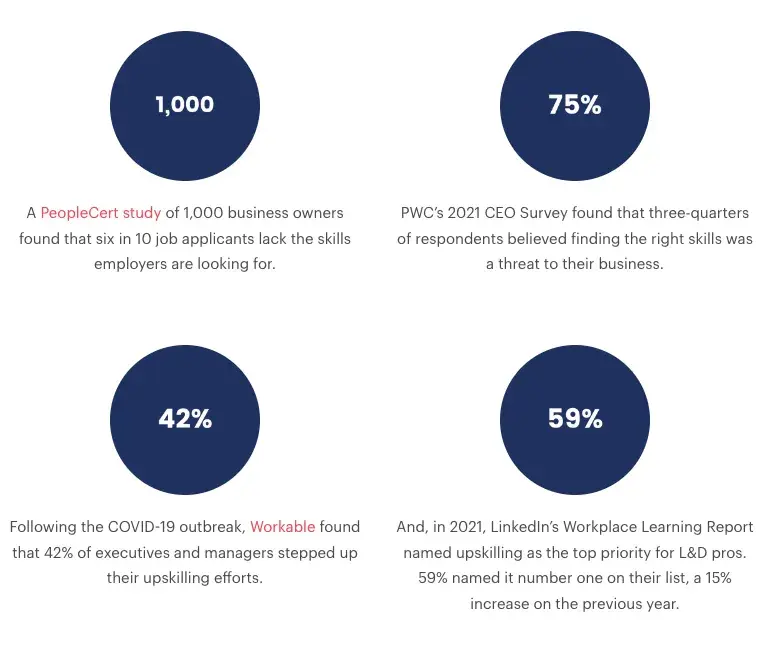
Focusing solely on the business response would undermine the significance of upskilling. It is a global issue influenced by various factors, holding the potential to bring significant advantages or challenges to numerous industries worldwide.
The drivers behind global upskilling and reskilling
According to the World Economic Forum’s (WEF) The Future of Jobs Report 2020, it was projected that by 2025, half of all global employees would require upskilling. Factors such as the growth of automation, the demand for high-skilled jobs, and responses to the pandemic were identified as significant influences leading to this remarkable figure.
Employees are not unaware of these changes in the job landscape. 39% of them believe that their jobs may become obsolete due to evolving skill requirements, and 60% attribute this concern to the impact of automation, which they believe puts numerous jobs at risk.
In a PWC Upskilling Hopes and Fears 2021 study that surveyed 32,500 workers, 77% expressed readiness to learn new skills or undergo complete retraining, and 74% viewed training as a personal responsibility. This demonstrates that employees are actively engaged and motivated when it comes to their career development.
Another encouraging report, a joint effort between the WEF and PWC, highlighted the economic benefits of upskilling employees, stating that “Wide-scale investment in upskilling has the potential to boost GDP by $6.5 trillion by 2030.” Additionally, if skills gaps are closed more rapidly, similar benefits could be achieved nearly two years ahead of schedule.
The response from people and businesses
They could easily attribute these changes to the evolving work environments that demand a response. However, it’s essential to recognize that our lifestyle, shopping habits, research methods, and interactions with products are also continuously evolving.
As people discover and utilize their products in new ways, it can lead to significant shifts in the skills required to effectively market, sell, and perform our jobs. This concept involves elements we can control and those we must respond to, a notion supported by the data.
According to the World Economic Forum (WEF) findings, companies estimate that 40% of their employees will need reskilling programs lasting six months or less. Moreover, a staggering 94% of business leaders believe that their employees should acquire new skills while on the job. These figures reflect the growing recognition of the importance of staying adaptable and responsive to the changing demands of the modern world.
The growth of digital roles is understandably considered a significant factor in the evolving skills landscape. However, they can equally attribute this transformation to the impact of hybrid working and the changes brought about by the pandemic. A remarkable 84% of respondents acknowledged that COVID-19 accelerated the digitization of work processes, and half of them believed it would expedite the adoption of task automation.
Interestingly, 42% of respondents revealed that the pandemic gave a significant boost to their upskilling and reskilling efforts. This finding reinforces the idea that upskilling and reskilling are not merely responses to evolving circumstances but are becoming important priorities in managing change and driving growth. As their work environment evolves rapidly, the importance of acquiring new skills to stay relevant and adaptable becomes increasingly evident.
Who upskills well and how do they do it? Companies closing their skills gaps
Upskilling may not be a magical solution, but gaining insight into how innovative companies are successfully implementing it can be truly enlightening! By understanding their strategies and approaches, we can avoid the skill trap door and effectively navigate the path to upskilling success.
L’Oréal: Responding to changes in their environment and budget
Let’s begin with L’Oréal, as their upskilling efforts are truly remarkable! However, to fully appreciate the beauty of their approach, we need to delve deeper into the details.
During an interview with Elise Ducret, L’Oréal’s Chief Marketing & Digital Officer, she disclosed how budget constraints and the impact of the pandemic led them to shift their focus from paid advertisements to leveraging SEO and content marketing.
“…it has become clear that SEO has regained its first place as a performance channel for us and become more important than ever”, with Ducret effusive in her praise for the brand credibility that quality content allows them build with their audience.
As part of their response, L’Oréal equipped their marketing teams with Botify, an automated tool that continuously updates and optimizes content to maintain search rankings. However, Elise Ducret’s statement, “We develop a content strategy, become subject matter leaders, and ensure we are capturing the interest of our consumers in a more authentic way,” suggests that their approach involved more than just adopting new software.
Although the specific details of their actions remain undisclosed, it is likely that L’Oréal made investments in content and SEO upskilling, considering their shift towards the primary digital channel. Simultaneously, the individuals managing paid advertising might have received training to reskill in this area, as ad spending was scaled back.
Moreover, the key takeaway from this example is that upskilling doesn’t always entail learning entirely new skills. Sometimes, providing teams with tools or technology that streamline processes can enhance productivity, and effectiveness, and foster a positive feedback loop that encourages future upskilling endeavors.
Amazon: Analysing your employee data to drive relevant skill development
Amazon, known for its swift product deliveries, has embraced a noteworthy long-term approach to upskilling. Their journey began by analyzing workforce and hiring data spanning five years, which led to the identification of their fastest-growing highly-skilled job roles. Building upon these insights, they devised a comprehensive upskilling strategy.
During their research, Amazon uncovered astonishing growth rates in specific key positions, including data mapping specialist (+832%), data scientist (+505%), solutions architect (+454%), security engineer (+229%), and business analyst (+160%). Additionally, considering the significance of customer fulfillment, Amazon noticed a substantial 400% increase in highly skilled jobs.
In 2019, they announced a significant investment of $700 million to upskill 100,000 employees in the United States by 2025, launching the ambitious initiative called “Upskilling 2025.” As part of this program, the e-commerce giant is diligently preparing its workforce to acquire essential skills through various avenues, including:
- Amazon Technical Academy: Amazon has introduced a program that equips individuals with the necessary skills to transition into software engineering roles. What makes this initiative even more remarkable is that it was developed by Amazon’s existing software engineers, emphasizing the importance of social learning and knowledge sharing within the company. The program adopts a project-based learning approach, ensuring that students grasp the practical application of the skills in real-life scenarios and on the job.
- The Machine Learning University: On the other hand, this particular program is exclusively available to individuals with a coding and tech background. Acknowledging the busy schedules of the participants, the program is designed as six-week modules, requiring only a half or full day of commitment per week. Throughout the duration, participants receive guidance from Amazon’s Machine Learning Scientists to ensure they acquire the appropriate skills effectively.
- Associate2Tech program: This course is available to IT support technicians at Amazon, offering them on-the-job training spanning 90 days. Additionally, Amazon covers the cost of their A+ Certification test, and with no degree required, the course is accessible to a wide range of individuals.
PricewaterhouseCoopers (PwC): Building a growth mindset and continuous improvement focus
“You can’t protect jobs, but you can protect people.” This succinct and profound statement captures the essence of upskilling, making it a delight to hear. Carol Stubbings from PwC emphasizes that during times of change and innovation, it’s crucial not to leave people behind. As their Joint Global Leader for People and Organization, she elaborates on this perspective:
“You have a responsibility to protect people and provide them with the right skills and the right training to enable them to be successful within your organization.”
As expected from its title, “Upskilling: Bridging the Digital Divide,” this 12-minute video primarily focuses on technological advancements, yet it offers valuable lessons applicable to a wide range of skills. The video emphasizes the significance of cultivating a positive mindset and fostering a culture that encourages employers to support and employees to eagerly pursue learning new skills.
Stubbings emphasizes the importance of people being open to learning and being receptive to upskilling opportunities. CitiBank’s Kate Matthews further elaborates on the mindset required for individuals to successfully embrace and pursue such development initiatives.
Tamal Bhattacharya, Senior Manager at PwC UK, shares a similar sentiment, stressing the significance of continuously improving oneself and acquiring new skills that will make individuals relevant for the future.
Upskilling lessons from the PwC experts
While inspirational quotes can be motivating, the real value lies in tangible takeaways that can be gleaned from the message. Here are some practical insights you can use to upskill your employees:
- Manage the pace of change: Richard Edelman, the President, and CEO at Edelman highlights the reasons behind people’s apprehensions about developing new skills: “At the moment, people are governed by their fears; two to one, they think that the pace of innovation is too fast.”Their responsibility is to alleviate concerns related to keeping up with rapid changes and to foster the development of skills necessary to stay relevant within those time constraints.
- Demonstrate internal mobility: As highlighted by Kate Matthews, your existing employees possess a level of company understanding that new hires simply cannot match: “It’s also easier in many ways to leverage the institutional knowledge you already have and add new skills to it, rather than bringing in new people from the outside.”Establishing an environment that encourages frequent and visible internal mobility emphasizes the value and significance of learning new skills while also recognizing and appreciating your top-performing employees.
- Get the right leadership in place: “First and foremost, we must motivate individuals to willingly embrace a continuous learning mindset and seize the opportunities it offers. Second, it is essential to offer comprehensive training, skill development, and coaching to enable people to grow and progress, ensuring both job security and access to future job opportunities.”
Bob Moritz, the Global Chairman of PwC, highlights the crucial importance of having the right individuals with strong leadership skills to lead and implement our upskilling strategies and foster a culture of continuous learning. Visionary leaders are essential, capable of not only translating plans into action but also inspiring and engaging people along the way.
Recognize the role of technology: Instead of fearing the evolution of technology, we should embrace tools that automate tasks that hinder their progress or those we find less enjoyable! Carol Stubbings emphasizes that:
AT&T: Self-awareness of how fast your industry is changing and creating clear paths to new roles
Acknowledging that half of their 250,000-strong workforce lacked essential critical skills for staying competitive required immense courage. AT&T faced the daunting task of upskilling 125,000 people. In 2018, the company publicly admitted this reality while undergoing a transformation from a voice network to a data network.
As they delved into the skills necessary to thrive in the new mobile- and software-centric world, they confronted a harsh truth: they lacked sufficient talent. Key areas of concern included science, engineering, math, and technology skills. Additionally, the company anticipated that 100,000 workers were in hardware-related roles that might become obsolete within a decade. This CNBC article captures AT&T’s journey through this transformative period.
At a critical juncture in their workforce’s skill development, Bill Blase, the Senior Executive Vice President of Human Resources, articulated the situation they faced.
“We could go out and try to hire all these software and engineering people and probably pay through the nose to get them, but even that wouldn’t have been adequate. Or we could try to reskill our existing workforce so they could be competent in the technology and the skills required to run the business going forward.”
They did not overspend; instead, they committed $1 billion to Future Ready, their reskilling initiative, which primarily offered online training, courses, and reskilling opportunities. While many companies might consider this investment sufficient, the more important question is: where do these acquired skills lead?
AT&T established its Career Intelligence portal, which highlights available jobs, the required skills for each role, and remarkably, whether that field is expected to grow or shrink in the coming years. This clarity allows employees to focus on learning skills relevant to roles with long-term viability, ensuring meaningful career development for AT&T’s workforce.
Walmart: Creating new career paths in high-demand areas
“As the largest private employer in the U.S., Walmart aims to be the market leader in providing retail workers a path to careers in growing fields like healthcare,”explained Ellie Bertani, Senior Director of Learning Strategy & Innovation at Walmart.
That’s why they opted for Penn Foster’s upskilling platform to offer pathways into healthcare careers. This tool provides on-demand, career-specific coursework that combines online learning with practical skill-building in the workplace. At the time of the announcement in 2019, all Walmart employees not currently working as opticians or pharmacy technicians were eligible to enroll in this training.
This decision came after the U.S. Department of Labor identified healthcare as the country’s fastest-growing industry, and Walmart recognized the opportunity to elevate employees into more secure and higher-paying positions.
Another valuable lesson from this is the importance of defining the purpose of your upskilling programs. By offering a pathway to roles that address real needs, organizations are more likely to tap into their employees’ motivation and sense of purpose!
Why should we upskill employees?
The benefits and advantages of upskilling
An alternative to hiring for skills and an incentive to retain staff
Can you genuinely anticipate employees to fully commit to your organization’s objectives if you’re not investing in their growth? Whether it involves enhancing their skill set or advancing into new roles, they won’t be able to achieve these goals without your support and encouragement.
Creating a culture that promotes internal mobility, upskilling, and continuous learning fosters loyalty among employees, demonstrating that career development opportunities await those who remain dedicated to the company.
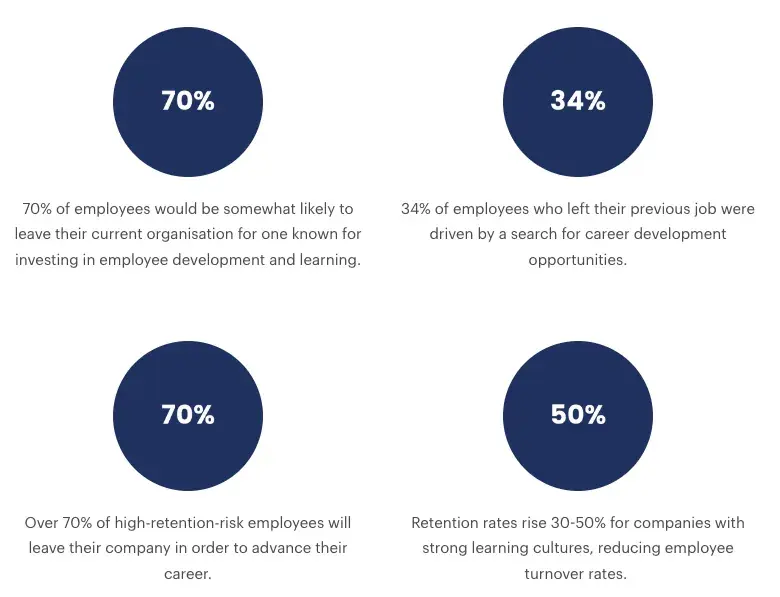
As demonstrated in their PwC example, leveraging existing institutional knowledge and enhancing it with additional skills is often more efficient than recruiting new employees externally.
Kate Matthews from CitiBank emphasizes that this approach not only saves on the expenses associated with hiring new staff to acquire critical skills but also reduces the productivity loss typically associated with onboarding external hires. Furthermore, retaining and upskilling current employees helps minimize the costs related to high employee turnover rates.
Improve your employer brand and attract top new talent
To attract the best talent and establish an appealing employer brand, you must demonstrate to potential employees that they have the opportunity to become the best version of themselves within your company through career development. This is where upskilling plays a crucial role.
Workable reports that 74% of candidates prefer to work at companies offering upskilling and reskilling opportunities. Similarly, an Amdocs survey found that 90% of respondents consider strong training and upskilling programs as essential features of prospective employers, with the figure rising to 98% for tech workers.
In the current hiring landscape, applicants hold more power, especially with the expansion of remote work, which opens up access to global talent pools. In this competitive environment, upskilling sets your organization apart and enhances resistance to employee turnover. Incorporating data on talent mobility and your investment in upskilling employees provides tangible evidence of your commitment to growth, making your company stand out to potential hires.
Keep pace with industry change and stay ahead of the curve
Skills have a limited shelf life! While some skills, like frying an egg, can endure over the years, remaining competitive and ahead of the game in corporate, office, and tech-based roles requires constantly learning in-demand skills.
Research indicates that the “half-life” of skills, or how long they remain relevant, is approximately five years, and it’s even shorter for technical skills. However, it’s essential to recognize that a skill can still be relevant but may lose its impact or effectiveness over time.
For instance, if you are skilled in managing Instagram and Snapchat, and suddenly TikTok emerges as a superior platform, your existing social media skills are still relevant but may not be as crucial as acquiring new talents in mastering TikTok.
As noted by Nelson Sivalingam, the CEO and Co-Founder of HowNow, in his book “Learning At Speed,” staying updated with in-demand skills is vital for maintaining a competitive edge in the ever-changing professional landscape.
Boost your bottom line and improve your economic position
Is it appropriate to treat “human capital” with the same approach as financial capital? According to McKinsey’s research, the answer is a resounding yes, as it can significantly improve our bottom line. Their findings reveal that “reskilling would generate positive economic returns in about three-quarters of cases,” and to fully reap the benefits of upskilling, approximately 90% of the workforce will need to undergo training.
As they will explore shortly, upskilling and reskilling lead to enhanced productivity, benefiting both individuals and businesses and resulting in improved performance. In large enterprises, 43% of upskilling initiatives would yield favorable outcomes, while small and medium-sized businesses would experience similar benefits in 30% of cases. The advantages of upskilling are a culmination of various benefits we’ll discuss in this section.
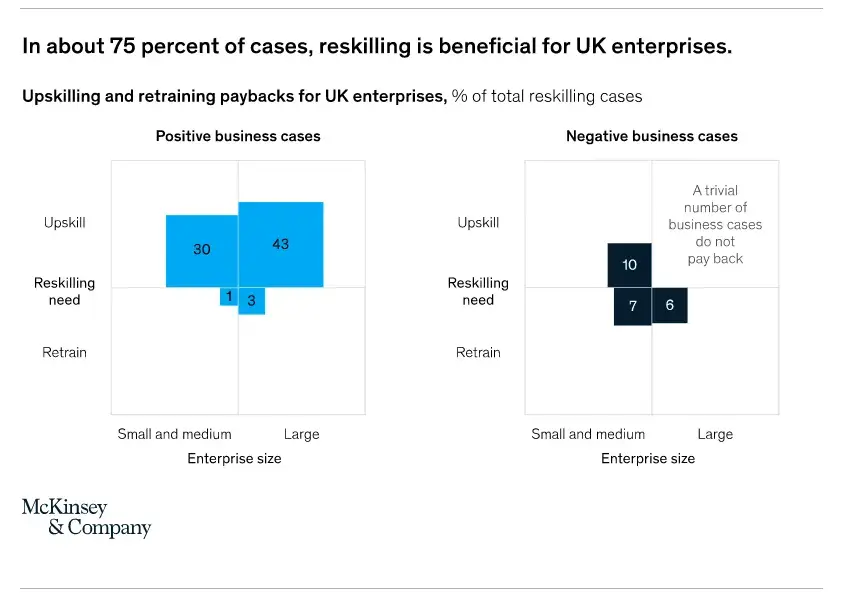
What about the remaining 25% of cases where upskilling may not yield economic benefits? Well, this situation often reflects how the upskilling process is executed. In those instances where profits do not increase, it raises questions about whether the necessary skills were properly identified and whether the upskilling efforts were effectively implemented. The answer is likely negative.
As pointed out by McKinsey, when employers require new or more advanced skills, and failure to act would erode their competitive advantage, reskilling becomes a favorable option. However, some businesses may adopt a “beats doing nothing” mentality, which might hinder them from fully embracing an upskilling program that could drive the business forward. Perhaps they need to develop new skills themselves or adjust their approach to upskilling to maximize its potential impact.
Build more productive teams and skilled employees
Increasing productivity often leads to positive outcomes across various key performance indicators. To illustrate the significant impact of upskilling efforts on productivity, let’s explore some compelling statistics.
According to Workable, a remarkable 91% of companies and 81% of employees have experienced increased productivity through upskilling and reskilling training. Moreover, McKinsey’s reliable research indicates that businesses can expect a productivity uplift ranging from approximately 6% to 12% when successful reskilling initiatives take place.
The reasons behind this boost are quite straightforward. By closing skills gaps, fostering professional development, and keeping abreast of industry trends, it’s no surprise that teams equipped with up-to-date skills and enhanced motivation will operate at peak performance levels.
Deliver better products, services, and customer experiences
While the debate over whether the customer is always right may continue, there’s no denying that they serve as the ultimate gauge of our performance. Their satisfaction, loyalty, and word-of-mouth recommendations are crucial indicators of our success in providing exceptional service.
One of the wonderful by-products of upskilling is its positive impact on customer experiences. When our teams are well-informed, motivated, and productive, and when we retain them over the long term, these factors collectively contribute to the quality of our offerings to the end user.
By understanding our customers and their usage patterns, we can tailor learning initiatives to address their specific needs and challenges. This targeted approach to upskilling ensures that our employees are equipped to serve customers more effectively, leading to even greater satisfaction and better overall experiences.
Build a culture of continuous learning and change management
As people engage in learning new skills more frequently, it gradually becomes a habit. When this habit is fostered within your teams, it paves the way for a culture of continuous learning to take root. With a strong emphasis on continuous learning, upskilling and adapting to change become much more achievable and streamlined processes.
Overcoming barriers to upskilling and tackling misconceptions
If upskilling initiatives haven’t been implemented yet, you might approach the topic with enthusiasm, hoping to persuade everyone to embrace it. However, not everyone may be ready to hop on the new skills train right away, and you might encounter pushback. It’s like having a ticket to success, but skeptical colleagues act as conductors, questioning whether it’s the right one.
The good news is that we’ve identified the four most common objections to upskilling and provided explanations on how to overcome them.
Resistance to change
Some individuals are simply resistant to change. They are content with the current approach to people development and fail to recognize the value of making adjustments. To them, if it’s not broken, there’s no need to fix it.
How to tackle it:
Make an effort to comprehend their reasons for being resistant to change and inquire about their pain points and challenges. By gaining this understanding, you can effectively explain why upskilling is a change that is worth embracing.
Cost concerns
When dealing with someone who is holding onto the purse strings tightly, presenting a new strategy that may require a budget shift or increase will likely face resistance due to concerns about the monetary cost.
How to tackle it:
Illustrate the potential cost of neglecting to upskill employees! Remind them that in 75% of cases, upskilling leads to a positive impact on the bottom line, and research suggests it can boost productivity by approximately 6% to 12%.
We’ll train people who leave for pastures in new
Some individuals may express cynicism regarding the outcomes of investing resources to upskill employees. While some can recognize the benefits it brings to the company, others might have reservations about the long-term effects. They may wonder if providing career development opportunities will lead employees to use their newly acquired skills to find better opportunities elsewhere.
How to tackle it:
Consider the following three facts: Employees often leave their jobs due to a lack of development opportunities, whereas they tend to remain in positions where they can acquire new skills. This indicates that upskilling has a positive impact on reducing employee turnover.
- Around 34% of employees who departed from their previous job were motivated by the pursuit of career development opportunities.
- Over 70% of employees classified as high-retention-risk are willing to leave their current company to advance their career development.
- Companies with robust learning cultures experience an increase in retention rates ranging from 30% to 50%.
We train people and that skill becomes obsolete
As they advocate for upskilling, we acknowledge that industries and required skills undergo frequent changes. Therefore, it’s not surprising that some may question the need to develop a skill that could become obsolete shortly after.
How to tackle it:
By providing an explanation that not all aspects of a skill become obsolete when learning something new, we can highlight the value of building upon existing knowledge. The foundation of what we already know enables us to be more adaptable, so even if a skill becomes outdated in a short period, it serves as a fundamental base for further learning and development.
Who’s responsible for upskilling employees? Key stakeholders to win over
No matter where you stand in the organizational hierarchy, they all play an important role in the upskilling process. Whether you’re a CEO allocating the budget or an employee embracing the idea of personal development, each one of us contributes to the success of upskilling initiatives.
For L&D, HR, or people development professionals, it’s essential to recognize that these individuals are your stakeholders. Gaining their support and buy-in is vital for the success of your upskilling endeavors.
CEOs
In 2019, 74% of CEOs expressed concerns about the availability of critical skills. The question is, how many of them took action to address this issue? CEOs have three powerful tools at their disposal to drive upskilling efforts. They can allocate the necessary budget to invest in their employees’ skill development, foster a culture of upskilling through effective management, and set a positive example by actively engaging in their own skill enhancement.
When the company’s top executive prioritizes personal skill development, it sends a clear message to everyone else. It becomes evident that there are no excuses for others not to do the same. Moreover, when CEOs understand how upskilling aligns with achieving business objectives, it influences how every related activity is communicated and implemented.
Learners
While their leaders can provide us with opportunities for learning, they cannot compel them to absorb all that knowledge. As employees, it is their responsibility to take ownership of their development and seize the chances presented to them. Even if a colleague offers to teach them a new skill, its effectiveness ultimately depends on their openness, enthusiasm, and willingness to apply it in practice.
Thankfully, most learners possess a strong sense of self-awareness. As demonstrated by the PwC statistic mentioned earlier, 77% of workers are prepared to learn new skills or undergo complete retraining, and 74% view training as a personal responsibility. Consequently, they should actively identify trending skills in their industry and assess where they may have gaps in their knowledge and abilities.
L&D, HR, and people development teams
With the approval of the higher-ups and the enthusiasm of the employees, the stage is set for upskilling to take flight. But who will design the framework to turn this vision into reality? That’s where the L&D, people development, or HR department steps in! From implementing the appropriate technology to aligning skills with company objectives and measuring the outcomes, these departments play a crucial role in launching successful upskilling programs.
If you belong to one of these departments and are wondering how to develop your upskilling strategy, the following sections in this guide will guide you through the process.
Management and leadership
Apart from your close friends at work and their spouses, who understands an employee better than their managers? Arguably, managers have the most in-depth knowledge of their team members – from understanding the intricacies of their roles to knowing their personal goals, aspirations, and characteristics. This wealth of information can be a valuable source of upskilling opportunities.
Creating personalized development paths relies on managers and their leadership skills! They are instrumental in collaborating with the teams mentioned earlier, shaping the development plans, and taking charge of their implementation and evaluation. In essence, managers play a critical role in fostering a culture of upskilling within the organization.
Analyzing and defining your current skill gap
If you’ve ever assembled flatpack furniture, you know exactly what a skill gap feels like! It’s that wide space between the abilities required to complete a task and the skills you currently possess. As it turns out, relying on just an Allen key and some pictures isn’t always sufficient to build a Scandinavian-sounding coffee table faster than it takes to learn its name.
For businesses, the stakes are much higher than simply assembling furniture. Having a lack of essential skills can lead to difficulties in staying competitive, decreased productivity, and hindered progress toward your goals. This is precisely why the next crucial step is to identify the existing skills gaps within your organization and develop an upskilling strategy to address them.
What causes skill gaps?
Similar to detectives arriving at a crime scene, you don’t immediately dive into the investigation without first gathering information. They ask for a summary of what is known so far. Likewise, as skill sheriffs, you must not rush into analyzing your skills gaps without understanding the underlying reasons. Otherwise, all your efforts and energy invested in upskilling could be in vain.
Here’s a concise report on the common causes of skills gaps – case closed!
- We stop learning!: Keep in mind that your skills have a half-life of just five years, and for more technical skills, it’s even shorter. If you neglect continuous learning throughout your career, your abilities can quickly become outdated.
- The industry changes: It’s possible that despite your ongoing learning, they might fail to notice the changing world around them. While they progress, there could still be someone out there relying on a fax machine, anxiously awaiting a response and unaware of how to send an email.
- The employers hesitate: The leaders need to be attuned to the ever-changing skills landscape and grasp the industry’s evolving trends. The speed at which they respond not only impacts the business’s performance but also influences the extent of the skills gap that emerges.
- New technology enters the equation: Technology has the ongoing potential to revolutionize the way you work, much like your fax machine example. Often, it automates mundane tasks, freeing up time for more impactful activities. Failing to adapt quickly to these technological advancements can give their competitors a significant advantage over them.
- Poor communication and understanding of applicant skills: When job applicants include specific skills on their CVs, employers often struggle to accurately gauge their proficiency in those skills. This lack of clarity regarding proficiency can have a significant impact on their ability to perform the job effectively.
- Ineffective learning and development strategies: If employees are only sent on a short training course once a year without ongoing, personalized development aligned with the company’s goals, it should come as no surprise that their skills might decline over time. For effective upskilling, L&D efforts must be continuous, tailored, and in line with the organization’s objectives.
- They presume we’re learning new skills: It’s a similar concept, but often they may be learning new things and assuming that they are upskilling. However, if these new skills do not have a significant impact, they need to question whether they are the right skills to focus on.
How to carry out a skills gap analysis, step by step
Step 1: Assess and understand your business and team goals
Without a clear destination in mind, any path will suffice! To apply this wisdom to upskilling, without a comprehensive understanding of the end goal, embarking on a skills journey may prove futile.
Initiating the process by assessing business and team objectives is paramount, as it provides the essential context for all subsequent stages. How can one effectively audit current skills without a grasp of the desired outcome and the impact those skills should deliver?
This task is usually portrayed as deceptively simple, but in reality, it is a complex undertaking that demands careful consideration and planning to close the skills gap effectively.
Step 1.5: Break down goals into stepping stones and gain more context
While your company goals may center around revenue generation, acquiring the skill of “revenue generation” alone is insufficient. Instead, you must delve deeper and comprehend specific metrics like average deal size or the number of signed contracts required to achieve the profit target.
Moreover, gaining insights into the inadequacies of our current process is important. Are they facing issues with lead generation or the quality of leads? Is their sales process too lengthy? Do potential customers drop off at a specific stage in the sales cycle? It’s not as straightforward as matching Goal A with Skill A in an upskilling approach.
Additionally, it’s essential to prioritize certain goals over others. If we are already making significant progress towards a particular target, upskilling a few team members might expedite our success, providing a quick win. This approach not only benefits the specific goal but also strengthens the overall upskilling initiative, showcasing its impact.
Step 1.9: Think ahead and look at your surroundings
In addition to your immediate fixed goals, it’s important to consider the company’s future direction. What might the next set of goals look like, and what lies on the horizon for our product or service?
Expanding your perspective, let’s also analyze the developments in your industry. Are there particular skills that are currently trending, and what might be the reasons behind their popularity? Remember, upskilling is about staying ahead of change; neglecting to do so only widens the skill gap. Conduct thorough research, study industry reports, and explore surveys relevant to your sector to gain a comprehensive understanding of ongoing trends.
By undertaking these steps, you’ll acquire a more data-driven, context-based, and actionable insight into the skills required to propel your company forward. This strategic approach will enable you to align your upskilling efforts with the company’s long-term vision and industry demands.
Step 2: Audit your current skills and proficiency
Once you’ve identified the necessary skills, the following crucial step is to conduct a thorough audit of the existing skills within your organization. However, this process goes beyond merely listing employees’ competencies; it requires a comprehensive understanding of their proficiency in specific skills and a well-rounded assessment of their talents.
Skipping this essential step in your upskilling strategy would hinder your ability to effectively measure the impact of your efforts. Without a clear starting point for skills, it becomes challenging to gauge the effectiveness of L&D initiatives in advancing those skills.
A successful skill assessment encompasses four key elements:
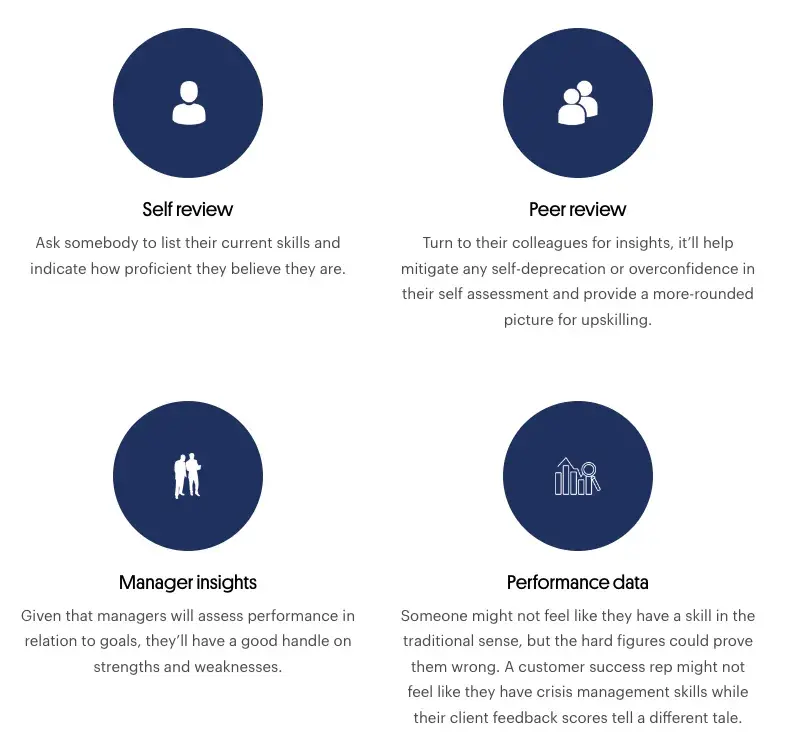
Upskilling FAQ: Where are we capturing, storing, and analyzing this skill data?
Let’s not even talk about spreadsheets! Our skills are not static; they evolve so rapidly that even someone well-versed in every Excel shortcut and formula will find it challenging to keep up with manual management.
Here are four rapid methods through which HowNow enables you to measure skills with greater speed and effectiveness:
Skill suggestions
When an employee clicks the “add skill” button, they provide skill suggestions based on their job role. These suggestions are derived from a pool of over 500,000 live job roles that we continuously measure and analyze. This enables you to gain insights into the in-demand skills required for the positions within your team.
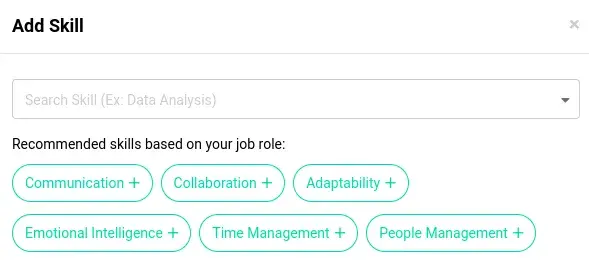
Guided self-assessment
Have you ever been asked to rate something on a scale of one to ten without any context about what each point on the scale represents? People need context to make informed decisions! That’s why we offer it by providing five levels of proficiency, ranging from Novice to Expert, to help individuals accurately assess their skills.
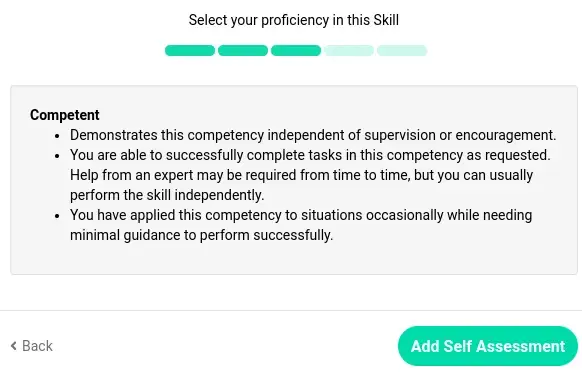
Request a peer review
Some of us may be too modest about our skills, while others may overestimate their abilities. That’s why getting a second opinion is essential. After completing a self-assessment, you can click on the three little dots next to your rating and request an endorsement from a colleague to provide additional feedback and validation.

Get quick insights into skills levels in your team
After investing time in collecting and assessing your skills, you’ll want to generate reports quickly. While we’re not quite as fast as blinking, with just a couple of clicks, you can filter skills by proficiency, job role, and the date they were last updated!
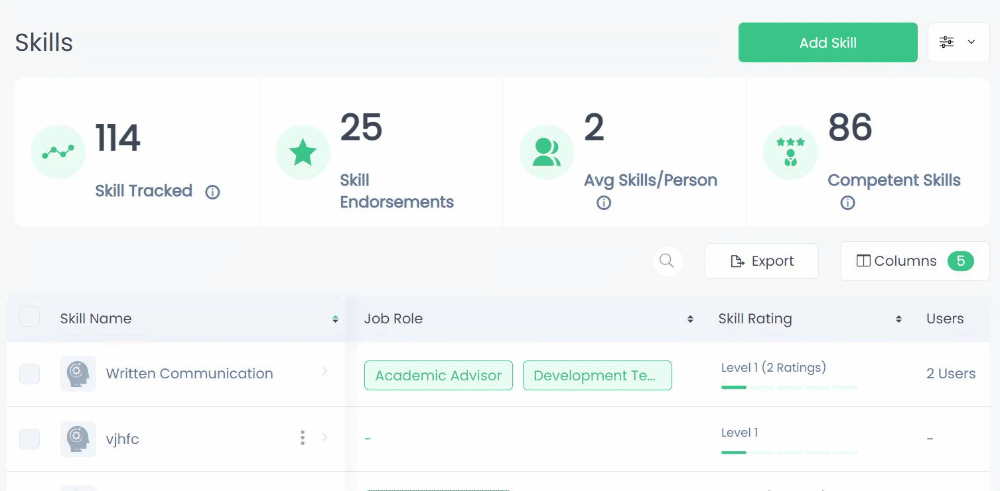
With this feature, you can swiftly identify the skills present in your team, their proficiency level, and whether they are up-to-date – all within one user-friendly dashboard.
Step 3: Mind (and measure) the gap
At this stage, you can approach the skills gap analysis from two perspectives.
- Quick wins: Skills that are required but currently lack the proficiency needed for effective performance.
- Long-term goals: Skills that are completely absent, presenting a separate and urgent challenge.
This important step helps you avoid the knee-jerk reaction of hiring external talent to fill gaps. Instead, it enables you to identify individuals with internal potential for growth and determine where external hires may be necessary. It’s about being thoughtful and prioritizing the most urgent talent needs.
Step 4: Closing the skills gap
Congratulations, you now have all the necessary tools to tackle skills gaps! This means you can direct your resources and upskilling efforts effectively.
The next important step is figuring out how to implement your plan. In this section, you’ll cover a few key aspects to help you wrap up your upskilling strategy.
The role of a personal skills gap analysis
Now, certain companies may not prioritize upskilling, leaving employees to take charge of their own talent development. On the other hand, some organizations may encourage individuals to conduct a personal skills analysis to identify their areas for improvement.
Here are a few steps that someone can take to carry out a personal skills analysis.
- Review job descriptions for similar roles and take note of the key skills mentioned.
- Have conversations with individuals in your current position or those you aspire to be in and inquire about their skill sets.
- Reflect on your own performance and identify your strengths. This will help you recognize your existing skills, as well as pinpoint areas where improvement is needed.
- Access reports and research related to your field. Many studies are easily available by filling out a quick form with some personal details. These resources will provide insights into the industry’s direction.
- Examine your own CV. While knowing when you acquired a skill is essential, it’s easy to forget the exact timeframe. Review your CV to analyze the duration since you acquired each skill.
How to upskill, reskill and develop your people
Even when two individuals need to acquire the same new skills, it’s highly improbable that they will share the same starting point, existing knowledge, or experience. Unfortunately, most upskilling guides overlook this crucial fact and present techniques as if they can be universally applied.
In reality, successful upskilling requires a deep understanding of the context in which you apply these techniques, as well as knowing where and why to implement them. Effectively identifying skills gaps and providing individuals with the necessary tools to bridge those gaps is one of the most overlooked and underrated leadership skills.
Personalize your upskilling and learning programs
Arguably the most important tool at your disposal is the recognition that effective upskilling is centered around individual people. When there’s a specific skill or proficiency gap in your team, you can identify potential in someone and leverage that potential to close the gap.
However, there are numerous variables at play, making a personalized approach essential. You must take into account:
- The existing level of skill and knowledge.
- Where has that been obtained (in the same company, industry, or elsewhere?).
- The day-to-day tasks or responsibilities of that individual.
- How that person likes to learn.
- Where that person works (both physically and in terms of tools they use).
- Their current performance and metrics in the role.
- Personal goals for that individual.
Upon reviewing all the information presented, it becomes evident that generic programs and courses cannot effectively address specific skill gaps.
By assessing individuals’ existing knowledge, you avoid wasting time teaching them what they already know. Understanding their current job and skill-building aspirations enables you to tailor learning to their specific needs. Recognizing the sources of their existing knowledge provides valuable context for determining the most relevant content. This personalized approach is the key to the power of upskilling!
Define impact: Without it, how do you know if you’ve achieved success?
In the midst of upskilling efforts, it’s not uncommon for people to lose sight of the purpose behind developing a skill. While the ultimate goal is typically to support the company in achieving its objectives, solely measuring skill proficiency without considering its impact can lead to an incomplete understanding of success. That’s why it’s essential to measure both aspects.
When creating upskilling pathways, it’s crucial to set clear goals that define the intended outcome. For instance, providing Person X with Skill Y to achieve Outcome Z. By doing so, you ensure that building the skill is not the sole focus, but also achieving the desired impact and results. Without this defined impact, the overall clarity of the upskilling initiative might be compromised.
Leverage social learning and your internal experts
You must remain vigilant against developing tunnel vision when it comes to upskilling. It’s easy to view upskilling solely as a way to introduce new skills to the team, but it’s equally important to focus on developing existing skills in more individuals.
In fact, building a sustainable upskilling strategy involves nurturing the skills already present within the organization, rather than constantly seeking external talent. For instance, if we have an expert in product launches and plan to increase our number of releases, relying solely on that one expert would be impractical. Instead, we should aim to cultivate this skill in more employees.
The expertise possessed by our product launch expert is valuable and should be shared with colleagues, as it is company-specific and gained through hands-on experience. To achieve this, you need to capture and make this knowledge accessible to the right people at the right times.
As an L&D professional or people manager, your role is to create formats and platforms that facilitate the capture and sharing of such valuable knowledge. Silos should be avoided, and the auditing of skills and proficiency becomes essential in ensuring that valuable expertise is not trapped within the organization.
Furthermore, if social learning is part of your upskilling approach, being an excellent listener and relationship builder is important. This enables you to identify the challenges employees face, the skills they require, and the appropriate moments to connect them with internal learning opportunities. By actively engaging and fostering relationships, you can enhance the effectiveness of the upskilling process.
Incorporate mentoring and coaching
In a similar vein, you may consider pairing two employees together for an extended period to facilitate knowledge transfer. Providing access to knowledge is one thing, but having a skilled colleague guide others through the journey of acquiring new skills is even more valuable.
Let’s say that one of the major challenges your team faces is converting leads into closed deals. You have enough leads coming in, but during the sales process, potential clients drop off before finalizing the deal. In this case, your subject matter expert and top deal closer can play a pivotal role in helping others master this skill.
This process could involve various steps, such as introducing them to the theory behind effective deal-closing strategies, allowing them to shadow calls and observe how deals are closed, conducting mock client meetings to practice their skills, and troubleshooting with them as they handle real-life challenges on the job. This hands-on and personalized approach can greatly enhance their proficiency in deal-closing and contribute to the overall upskilling efforts of your team.
Create low-stress practice environments
Whether through mentoring or other means, creating practice environments can be a highly effective way to ease the pressure of developing new skills. Take KFC, for instance, which utilized virtual reality restaurants to train its chefs, recognizing that providing a less stressful kitchen environment for practice can lead to better skill development.
While not everyone needs a VR game and headsets, the underlying principle holds true. Striking a balance between learning theory and practical application is important, particularly in roles that involve interactions with people. It’s essential to avoid situations where employees learn about crisis management one day and then immediately face a full-blown customer meltdown the next. Similarly, developing compassionate leadership skills during challenging times in one-on-one settings can be daunting.
To address this, consider incorporating practice pitches, self-tests, and low-pressure scenarios to assess proficiency. By offering opportunities for individuals to practice and build confidence before diving into high-pressure situations, you empower them to be better prepared for real-life challenges. This approach ensures a smoother transition between skill development and on-the-job application, ultimately leading to more effective upskilling outcomes.
Offer microlearning and short-form content
Not only is brevity often the essence of wit, but it’s also precisely what people crave when they urgently need to learn something new! When you’re trying to develop a skill on the job or during client interactions, you don’t require a lengthy course or a colleague to help them; you need immediate guidance that you can quickly digest and apply.
This is where microlearning comes into play in the realm of upskilling. Let’s revisit the crisis management example. During a customer call when the system suddenly crashes, your response time and quality are important. In such a high-pressure situation, you don’t have time to delve into lengthy PDFs or wait for a colleague’s response. What you need is instant access to concise, step-by-step guidance on handling system failures.
If you can search your knowledge base and find a short-form resource that precisely addresses the issue at hand, you can effectively manage the crisis and perform better. Having access to microlearning resources allows you to quickly learn and apply the necessary skills in real time, leading to positive experiences and successful skill development. On the contrary, struggling through the situation without immediate and concise support could have a detrimental impact on customer interaction and your overall performance.
Provide access to on-demand content
When it comes to learning, each of us has our own unique preferences and styles. Some are early birds, while others are night owls; some prefer learning on mobile devices, while others are more comfortable with desktop studying. However, a common frustration in many companies is the lack of on-demand content. How can we effectively upskill employees if they can’t access the information they need at the moment they need it?
While there is a significant emphasis on providing the right content, the medium is often overlooked. As we discussed earlier, it is vital that people can readily access the resources they require on demand. For instance, if you host monthly live sessions on important topics, consider uploading the recordings for employees to watch at their convenience. Enhance the user experience by adding timestamps for each issue discussed, allowing employees to navigate directly to the relevant sections. Additionally, include a comments section to promote social learning and encourage interaction among learners.
Here at CourseMonster, we know how hard it may be to find the right time and funds for training. We provide effective IT Certifications that enable you to select the training option that best meets the demands of your company.
For more information, please get in touch with one of our course advisers today or contact us at training@coursemonster.com




Comments ()